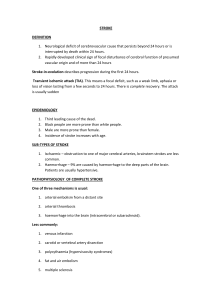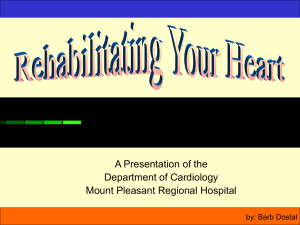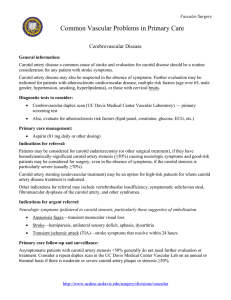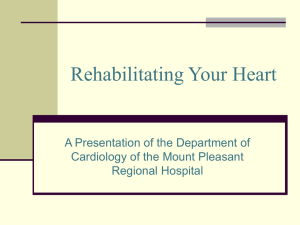Group E - Vascular
advertisement
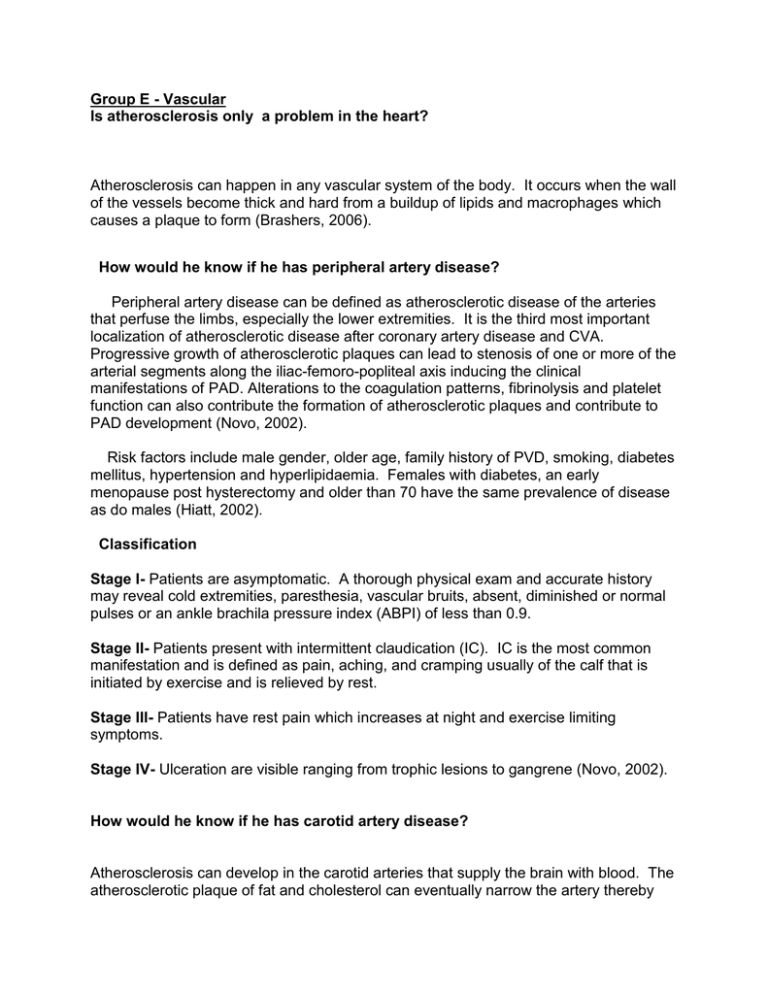
Group E - Vascular Is atherosclerosis only a problem in the heart? Atherosclerosis can happen in any vascular system of the body. It occurs when the wall of the vessels become thick and hard from a buildup of lipids and macrophages which causes a plaque to form (Brashers, 2006). How would he know if he has peripheral artery disease? Peripheral artery disease can be defined as atherosclerotic disease of the arteries that perfuse the limbs, especially the lower extremities. It is the third most important localization of atherosclerotic disease after coronary artery disease and CVA. Progressive growth of atherosclerotic plaques can lead to stenosis of one or more of the arterial segments along the iliac-femoro-popliteal axis inducing the clinical manifestations of PAD. Alterations to the coagulation patterns, fibrinolysis and platelet function can also contribute the formation of atherosclerotic plaques and contribute to PAD development (Novo, 2002). Risk factors include male gender, older age, family history of PVD, smoking, diabetes mellitus, hypertension and hyperlipidaemia. Females with diabetes, an early menopause post hysterectomy and older than 70 have the same prevalence of disease as do males (Hiatt, 2002). Classification Stage I- Patients are asymptomatic. A thorough physical exam and accurate history may reveal cold extremities, paresthesia, vascular bruits, absent, diminished or normal pulses or an ankle brachila pressure index (ABPI) of less than 0.9. Stage II- Patients present with intermittent claudication (IC). IC is the most common manifestation and is defined as pain, aching, and cramping usually of the calf that is initiated by exercise and is relieved by rest. Stage III- Patients have rest pain which increases at night and exercise limiting symptoms. Stage IV- Ulceration are visible ranging from trophic lesions to gangrene (Novo, 2002). How would he know if he has carotid artery disease? Atherosclerosis can develop in the carotid arteries that supply the brain with blood. The atherosclerotic plaque of fat and cholesterol can eventually narrow the artery thereby reducing blood flow to the brain which may lead to a stroke. There are 3 ways that atherosclerosis can cause stroke (Heart disease: Carotid artery disease, n.d.). 1. the artery becomes very narrow 2. part of the plaque breaks off and creates a thrombus that can block smaller arteries in the brain 3. a clot forms in a narrowed artery (Heart disease: Carotid artery disease, n.d.). There may not be any symptoms noted with carotid artery disease. The first sign may be a transient ischemic attack (TIA) which may lead to a stroke. Symptoms of a TIA include: 1. Visual disturbances such as blurred vision or bilateral/unilateral loss of vision 2. Difficulty speaking or comprehending others, slurred speech 3. Weakness or parasthesia unilaterally of arms, legs, or face 4. Dizziness, confusion, impaired coordination 5. Difficulty swallowing (Heart disease: Carotid artery disease, n.d.). Mr. H’s doctor may also be able to hear bruits, which is a rushing sound, on physical exam by listening to the carotid arteries with a stethoscope. These are not always heard if there is a blockage. His doctor may order tests to diagnose carotid artery disease such as an ultrasound, angiography, or CT scan (Heart disease: Carotid artery disease, n.d.). End organ damage – clinical signs and symptoms Over time, an elevated blood pressure can have a significant impact on other organs in the body. Organs that may be affected are the brain, heart, retinas of the eyes, and kidneys (Hypertension, 2008). Each affected organ will display its own clinical manifestations. CVA – drooping or loss of facial muscle tone, altered or lack of muscle tone/movement of limbs, slurring or inability to speak or understand language (aphasia), numbness, reduction of vibratory sensation, altered sense of smell, taste, hearing or vision, drooping of eyelid, decreased gag or swallow reflexes, difficulty with balance, altered respiratory and heart rates, deficits in memory, confusion, loss of consciousness (Stroke, 2008). Myocardial infarction – symptoms may have a gradual or sudden onset with varying degrees of intensity. Chest pain (tightness, squeezing or pressure), pain radiating to the left or right arm, neck or jaw, or back are possible. Pain to the epigastrium may be mistaken for heartburn. As well, shortness of breath, pulmonary edema, diaphoresis, weakness, nausea, vomiting, palpitations, light-headedness or loss of consciousness or sudden death are possible (Myocardial Infarction, 2008). Lab values for CK, CK-MB and Troponins will be elevated and ST segment changes in 12-lead ECG (ibid.). Congestive heart failure – low output heart failure, which can occur in patients with hypertension, may show clinical signs of impaired peripheral circulations and vasoconstriction (initially) such as cold, pale and cyanotic extremities, decreased stroke volume, and narrowing of pulse pressures (Quaal, 1992). Other symptoms include fatigue, irregular pulse, edema to extremities, weight gain, nausea, shortness of breath, bloating and increased need to urinate at night time (Hypertensive heart disease, 2008). Hypertensive retinopathy - Hypertension can cause damage to the retina of the eye. Signs of hypertensive retinopathy include arteriosclerotic changes where: Arteriolar narrowing of various degrees (often bilateral): Grade I – ¾ normal caliber Grade II – ½ normal caliber Grade III – 1/3 normal caliber Grade IV – thread-like or invisible (Hypertensive Retinopathy, 2008) As well, vessel sclerosis, ischemic changes, hemorrhage, edema, optic disc edema (papilledema) and although some patients may not have visual symptoms, some may have decreased vision and headaches (ibid.). Hypertensive nephropathy – Irreversible loss of kidney function is possible consequence to uncontrolled hypertension. The signs and symptoms of uremia (a number of symptoms caused by the decline of renal function and the increase of plasma toxins), are increased urea and creatinine, decreased GFR, anorexia, nausea and vomiting, diarrhea, weight loss, edema, pruritus and possible neurological changes (Gray, Huether, & Forshee, 2006). Hypertensive encephalopathy – If blood pressure remains elevated, capillary permeability increases, allowing vascular fluid to seep into the interstitial space. Cerebral edema ensues and cerebral dysfunction will be a result (McCance, 2006). Signs and symptoms of encephalopathy are an altered mental state such as: loss of cognitive ability, personality changes, lethargy, difficulty in concentrating, and decreased level of consciousness (Encephalopathy, 2008). As well, neurological signs may manifest as muscular twitching (myoclonus), loss of muscle tone with quick restoration of tone (asterixis), rapid, involuntary eye movement (nystagmus), seizures, tremor and changes n respirations (ibid.). References Brashers, V.L. (2006). Alterations of cardiovascular function. In K.L. McCance & S. E. Huether (Eds.), Pathophysiology: The biologic basis for disease in adults and children (5th ed., p. 1081-1146.). St Louis, MO: Mosby. Encephalopathy. (2008, May 30). In Wikipedia, The Free Encyclopedia. Retrieved 19:04, June 22, 2008, from http://en.wikipedia.org/w/index.php?title=Encephalopathy& oldid= 215890554 Gray, M., Huether, S. I., & Forshee, B.A. (2006). Alterations of renal and urinary tract function. In McCance, K.L. & Huether, S.E. (Eds.) Pathophysiology: The biologic basis for disease in adults and children (pp.1301-1335). St. Louis, MO: Elsevier Mosby. Heart disease: Carotid artery disease. (n.d.). Retrieved June 24, 2008 from http://www.medicinenet.com/carotid_artery_disease/page2.htm Hiatt, R. W. (2002). Preventing atherothrombotic events in peripheral arterial disease: the use of antiplatelet therapy. Journal of Internal Medicine, 251, 193-206. Hypertension. (2008, June 22). In Wikipedia, The Free Encyclopedia. Retrieved 16:50, June 22, 2008, from http://en.wikipedia.org/w/index.php?title=Hypertension&oldid=220953304 Hypertensive heart disease. (2008, May 28). In Wikipedia, The Free Encyclopedia. Retrieved 18:15, June 22, 2008, from http://en.wikipedia.org/w/index.php?title= Hypertensive_heart_disease&oldid=215593729 Hypertensive retinopathy. (2008, April 5). In Wikipedia, The Free Encyclopedia. Retrieved 18:26, June 22, 2008, from http://en.wikipedia.org/w/index.php?title=Hypertensive_retinopathy&oldid= 203436920 McCance, K.L. (2006). Structure and function of the cardiovascular and lymphatic systems. In McCance, K.L. & Huether, S.E. (Eds.) Pathophysiology: The biologic basis for disease in adults and children (pp.1029-1146). St. Louis, MO: Elsevier Mosby Myocardial infarction. (2008, June 21). In Wikipedia, The Free Encyclopedia. Retrieved 17:51, June 22, 2008, from http://en.wikipedia.org/w/index.php?title=Myocardial_infarction&oldid=22069816 6 Novo, S. (2002). Classification, epidemiology, risk factors, and natural history of peripheral artery disease. Diabetes, Obesity and Metabolism, 4(2), 1-6. Stroke. (2008, June 22). In Wikipedia, The Free Encyclopedia. Retrieved 17:05, June 22, 2008, from http://en.wikipedia.org/w/index.php?title=Stroke&oldid=220893600 Quaal, S. J. (1992). The person with heart failure and cardiogenic shock. In Guzzetta, C.E. & Montgomery-Dossey, B. (Eds.) Cardiovascular nursing: Holistic practice (pp.302-354). St. Louis: MO: Mosby.
